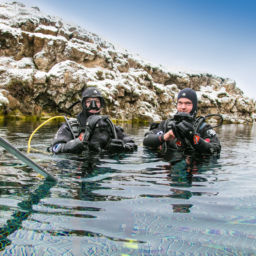Silfra, Iceland probably doesn’t pop to mind when thinking about a scuba destination. But it should, for the small island nation in the middle of the Atlantic offers some of the world’s most unique scuba diving. The most unique of these sites may be Silfra fissure in Þingvallavatn Lake.
Silfra fissure lies within Þingvellir (or Thingvellir) National Park in the western part of the island, about an hour from Reykjavik. It’s a result of Iceland’s unique geographical and geological properties. The entire island is situated on top of a fault line between two tectonic plates. The fault line runs from the northeastern corner of the island to the southwestern. This is the cause for Iceland’s famous hot springs, but also it also causes a number of rifts in the ground. Some of these have filled with spring water. They can vary from only quite small to, in Silfra’s case, hundreds of feet long, deep enough to scuba dive.
Silfra consists of a large tectonic fissure. It ranges from up to 60 feet/20 meters wide to spots narrow enough that divers can put one hand on the North American continent and the other hand on the Eurasian continent simultaneously. It’s the only spot on Earth where divers can dive directly in the crack between two continental plates. In the middle of the lake is the lagoon, a large, circular area some 300 feet/100 meters across. The cold water hovers near 35 F/2 C year-round. Divers often split the lake into two dives of 20 to 25 minutes each.
Many divers may wonder what’s so appealing about a cold-water lake in the middle of the wind-swept North Atlantic. The two main draws are the visibility and the geology, which is unlike that any other dive site. The Silfra fissure consists of a few sections, including Silfra Hall, Silfra Cathedral and Silfra Lagoon. You’ll spend the majority of the dive in a narrow rift, with dramatic rock walls on either side. The whole thing opens up into the wide lagoon, only to narrow again. All the time, you’re literally diving in between continents.
But as spectacular as the geology is, the visibility is the real attraction. In the lagoon, which as stated earlier is about 300 feet at its widest point, you can clearly see from one side to the other. Visibility is so good that Icelandic dive companies often warn that people suffering from vertigo should be careful about diving in Silfra. They are often uneasy hovering in what the locals call “liquid air.”
You’ll never think of great visibility the same once you’ve dived Silfra.


